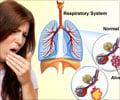The biology of lung cancer differs from one patient to the next, depending on age and sex, according to scientists at Duke University Medical Center.
The biology of lung cancer differs from one patient to the next, depending on age and sex, according to scientists at Duke University Medical Center.
The findings may help explain why certain groups of patients do better than others, even though they appear to have the same disease."Our study supports two key findings: First, the biology of lung cancer in women is dramatically different from what we see in men. Women, in general, have a less complex disease, at least in terms of the numbers of molecular pathways involved. We also discovered that there is a subset of elderly patients would probably benefit from treatments that we've normally reserved for younger patients," says Anil Potti, M.D., an oncologist in the Duke Institute for Genome Sciences & Policy (IGSP) and the senior author of the study.
Potti says that in the past, physicians have had to rely on very rough measures to categorize patients' lung cancers, factors such as the size of the tumor, the tissue type and the degree to which the cancer had spread. "But this new information tells us that we can analyze patients' disease much more discretely," says Potti. He says the information could also be used to enrich the selection process in clinical trials designed to evaluate new drugs aimed at specific molecular targets.
Physicians have long observed that over time, women with lung cancer tend to do a little better than men, and that younger patients do better than older ones. Potti found that women tend to have only a few cancer-promoting pathways activated in their tumors, where men may have twice as many.
Potti and a team of researchers in the IGSP studied clinical data and accompanying genomic information obtained from tumors of 787 patients with predominantly early stage non-small cell lung cancer (NSCLC), the most common form of the disease. They gathered tumor samples and corresponding microarray data showing which genes were activated in the tumors, then selected twelve of the most common molecular pathways that become dysregulated in NSCLC. The goal was to identify any patterns linking the pathways to age, sex and time to recurrence. They sorted the patients by age and sex and then again into low- and high-risk groups, based on five-year, recurrence-free survival.
They found that certain molecular pathways were more frequently activated in some groups than others and that certain pathway patterns were associated with better long-term survival in patients with lung cancer. Specifically, they found that:
- High-risk patients – those with the shortest time to recurrence – were significantly more likely to have increased activation of the pathways responsible for tumor metastasis and necrosis, when compared with low-risk patients.
- High-risk patients 70 or older were found to have higher activation of pathways regulating blood supply and invasiveness.
- In comparing high-risk women to high-risk men, they found that men were more likely to have a much more complex pattern of multiple pathways being activated than women with the same type of lung cancer.
Potti says it is likely that there are additional cancer-promoting pathways that are involved in the development and progression of NSCLC and adds that these findings must be validated in other studies. But he said the set of 12 known oncogenic pathways they chose to study are significant "because we already have drugs that can regulate many of them."
"People still don't realize how bad a disease this is," says Jeffrey Crawford, M.D., a study co-author and the chief of medical oncology at Duke. "Lung cancer kills more than 150,000 patients each year in the U.S. – more than breast, prostate, colon and ovarian cancer combined. Unfortunately, there is a patient dying from lung cancer every three minutes in this country. So being able to better understand the disease and stratify patients by their individual molecular profiles means we can do a much better job pairing the right drug with the right patient."
Source-Eurekalert
SAV













